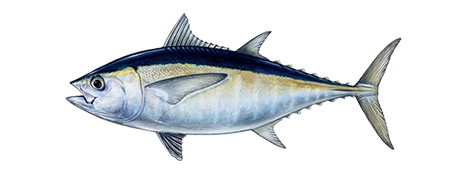
Blackfin Tuna
The blackfin tuna has some local commercial importance, but is predominately an angler’s fish and a spunky game species.

Region
South
Catch ease
Medium
Habitat
Ocean
How to identify a Blackfin Tuna
The pectoral fins reach to somewhere between the twelfth dorsal spine and the origin of the second fin, but they never extend beyond the second dorsal fin as the above albacore. There is a total of 19-25 (usually 21-23) gill rakers on the first arch (15-19 are on the lower limb), which is fewer than in any other species of Thunnus. The finlets are uniformly dark, without a touch of bright lemon yellow usually present in those of other tunas. Light bars alternate with light spots on the on the lower flanks.
Where to catch Blackfin Tuna
The blackfin tuna inhabits tropical and warm-temperate waters of the western Atlantic Ocean. There are scattered records of blackfin tuna occurring as far north as Martha's Vineyard, Massachusetts, but the usual range is from North Carolina to Rio de Janeiro, Brazil, including the Caribbean Sea and the Gulf of Mexico. The following list includes additional details on where to catch this fish:
| Baitfish Patches |
| Coastal Waters |
| Floating Foam and Debris |
| Night Fishing |
| The Open Ocean |
| Birds |
| Deep Shore Water |
| Merging Water |
| Reefs, Wrecks, and Shoals |
How to catch Blackfin Tuna
This is a pelagic, schooling fish that generally feeds near the surface. Its diet consists of small fishes, squid, crustaceans, and plankton. An excellent light tackle of species, it can be taken by trolling or casting small baits or lures, including ballyhoo, mullet and other small fishes as well as strip baits, spoons, feathers, jigs, or plugs; or by live bait fishing from boats at the surface of the deep waters one to two miles offshore. The following are fishing methods used to catch this fish:
Blackfin Tuna lures, tackle & bait
The following are lures, tackle or bait that can be used to catch this fish:
